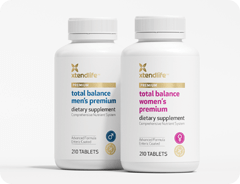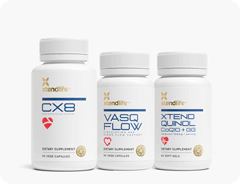By Dr. Joel Kahn, MD, FACC
Your chest slowly begins to tighten up, and you feel it in your throat and left shoulder. It is not a pain but a dull and scary pressure. Your breathing is heavy, and your skin is moist. You feel slightly dizzy and cannot figure out what is happening. It has been 20 minutes, and the feeling has gotten more intense. You are having a heart attack, also known as myocardial infarction (MI), and your heart muscle is dying. Your very life is at risk. You are joining one of nearly 800,000 persons every year in the USA alone that suffer a MI.1 In terms of death, heart disease is the leading cause of death for men in the United States with a death every 34 seconds—that’s one in every four male deaths.2 At younger ages, men face a greater risk of heart disease than women. On average, a first MI, the most common manifestation of this prevalent disease, strikes men at age 65.
Nearly 10% of men have a known diagnosis of coronary heart disease (CHD), which is a term for clogged heart arteries causing angina chest pressure, a MI, and the need for heart stents and bypass surgery. But many more have CHD and it unknown to them and their medical team. Tragically, half of the men who die suddenly of coronary heart disease, hundreds of thousands, have no previous warning symptoms and no chance in the traditional medical model to be diagnosed before death. The key message of research statistics is that even if a man has no symptoms, he may have CHD and still be at risk for CHD and heart death.
After World War II the number of cases of CHD began to rise. Until the early 1950s, CHD was largely regarded as a feature of aging. Certain keen observers like Paul Dudley White, MD, of the Harvard Medical School disagreed and felt a large proportion of MI and cases of CHD could be predicted by “risk factors” developed from research studies like the Framingham Study initiated in the late 1950s.3 These studies identified that high blood pressure, high LDL cholesterol, and smoking were the key risk factors for CHD. About half of Americans (49%) have at least one of these three risk factors.4 Several other medical conditions and lifestyle choices can also put a man at a higher risk for heart disease, including diabetes, overweight and obesity, a diet high in processed foods, physical inactivity, and excessive alcohol use.2 This science led Dr. White to conclude from the 1950s onward that “Death from a heart attack before the age of 80 is not God’s will, it is man’s will.”5 The matter of heart attack prevention is pressing because over 1,000 people a day in the US alone experience a heart death judged to be preventable by the Center for Disease Control in Atlanta.6 The following steps are suggested as a comprehensive and effective strategy to identify CHD in men before a heart attack occurs.
Step 1: Clinical Clues to Silent CHD
CHD progresses silently for years before a MI or death occur, but there are clues to “sick” blood vessels in other parts of the body that can be an early warning system to CHD.
Erectile dysfunction (ED). Some men have a built-in warning system for silent CHD. When achieving an erection is difficult or impossible, it can be a sign of clogged arteries in the pelvis that presents before a heart attack hits a few years later. There are, on average, three to five years between the onset of ED and the finding of CHD, which is plenty of time to detect and to work on preventing heart issues.7 Unfortunately, the norm in clinical practice is a Rx for an erectile dysfunction drug without a consideration of the risk of CHD. A full evaluation for silent CHD has been recommended by expert panels.8
Baldness. In a comprehensive study of almost 37,000 men, severe baldness at the crown of the head strongly predicted the presence of silent CHD at any age.9
Gray hair. A new study presented in Europe at EuroPrevent 2017 found that a high amount of gray hair is a risk factor for silent heart atherosclerosis. A total of 545 adult men without known heart disease had a CT angiogram of their heart arteries, a very accurate way to identify silent problems. Having equal amounts of gray and dark hair, or mainly gray and white hair, correlated with finding silent heart blockages. The researchers hypothesized that atherosclerosis and hair graying occur through similar biological pathways.10
Diagonal ear lobe crease. One of the strangest of markers, a crease in the earlobe (specifically, an angled crease in the ear that runs diagonally from the canal to the lower edge of the earlobe) has been mentioned in medical research reports as a sign of silent CHD. The ear lobe crease may result from poor circulation or a nutritional deficiency in collagen production. Although some medical professionals have argued that a crease is just a general sign of aging, researchers used the most sophisticated CT scan method to measure silent CHD and found that ear lobe crease predicted CHD even after accounting for other risk factors, such as age and smoking.11
Calf pain on walking. This is known as claudication (from the Latin for “to limp”). Atherosclerosis can block leg arteries, particularly in smokers, before CHD is diagnosed. This symptom requires an evaluation without delay. An examination of the pulses in the legs and simple measurements of leg blood pressure and blood flow can confirm a diagnosis of poor circulation and increased MI risk.12
Step 2: Determine Arterial Age
The concept of “arterial age” to predict longevity goes back to the 1600s when a leading English physician, Thomas Sydenham, MD, wrote that “a man is as old as his arteries.” While there are recommendations to search for breast and colorectal cancer, there is no routine screen to identify silent CHD.13 The American Heart Association recently updated its guidelines for the management of cholesterol to consider a simple CT scan of the heart known as a coronary artery calcium score (CACS) as pivotal in deciding on therapy.14 In addition, a large analysis of the predictive power of the CACS and the use of cholesterol lowering statin medication was published that makes it clear that getting a CACS is the most important step to assess the risk of a heart attack.15
A CACS was developed as a screening test for silent calcified heart arteries using specialized CT scanners called EBCT but is now performed on the widely available multi-slice scanner at most hospitals and even some larger clinics.16 The test simply requires holding one’s breath and is independent of heart rate or blood pressure. A second type of heart CT scan called a coronary CT angiography or CCTA requires that contrast agents be injected and is not used as a screening tool. It is now available with AI interpretation and is a major advance for those with an abnormal CACS.
The CACS test takes under 30 seconds and is painless. With modern software algorithms and CT scanners, the radiation exposure is less than 1 mSv, or on par with a mammogram. The CACS is not a yearly examination and might be repeated every 5-10 years (or never) so the radiation exposure is considered low. It is a screening test for silent CHD, so it is not appropriate for persons with a prior MI, stent, coronary bypass, or known atherosclerosis of other parts of the body like a carotid endarterectomy. Additional considerations are the potential incidental findings (pulmonary nodules, enlarged lymph nodes, and thoracic aortic aneurysm).
The CACS requires calcification of heart arteries, sometimes called hard plaque. Soft plaque that is not yet calcified may also threaten the health of men but will not be identified on a CACS. A digital carotid ultrasound called a carotid intimal-medial thickness (CIMT) can show both hard and soft carotid plaque years before an event.17 A CIMT is a 20-minute ultrasound of the neck that uses advanced software measurements to examine carotid arteries for plaque, and also measure the thickness of arteries, another sign of aging. The biggest drawback of the CIMT is finding a quality center that offers it.
Step 3: Measure Advanced Labs
The standard annual wellness examination or even executive physical generally involves the same laboratory evaluation that was obtained 20-30 years ago. The field of lab testing for genetic and acquired heart risk is advancing rapidly and widely available. Here are some tests to consider.
Advanced lipid profile. Rather than a calculated LDL cholesterol level, advanced panels measure LDL particle number and size directly, which are more accurate and predictive of future heart and stroke events.18 Two people with the same total and calculated LDL cholesterol levels can have widely different particle and size measurements, making for very different risks.19
hs-CRP. The high sensitivity C-reactive protein is a blood test patented by Harvard Medical School to measure inflammation or the “fire” that results from an irritated immune system. The higher the hs-CRP the greater the risk for atherosclerosis, heart attack, stroke and even other conditions like cancer and dementia.20
Lipoprotein (a). This is a genetic form of cholesterol that’s elevated in about 20% of those tested and unaffected by most lifestyle measures or statin medication. It’s rarely drawn even though hundreds of research studies indicate that if it’s high, the risk of heart attack and stroke skyrocket. It runs high in many families that have been decimated by heart disease.21
Homocysteine. This amino acid is produced by a process called methylation. It can injure arteries when elevated. It may be due to a genetic defect in the MTHFR gene, which is easily measured or due to nutritional deficiencies of B vitamins. Homocysteine can be lowered with B-complex vitamins.22
TMAO. This is a newly described marker of heart and kidney health that’s elevated after eating meat- and egg-heavy diets with an altered gut microbiome. It has been shown to cause heart and kidney damage, and is associated with worsened prognosis.23
apoE. This is a genetic marker related to cholesterol metabolism that is measured from a blood sample. For the few that inherit a pattern called apo E 4/4, the risk of heart disease and Alzheimer’s disease is high and may have an onset 15-20-years earlier than average.24
Step 4: Calculate an Astro-CHARM Score.
A major advance in 2018 was the publication of the application called the Astro-CHARM score.25 The online risk calculator is a collaboration of NASA and the University of Texas Southwestern Medical Center and is the most advanced tool available. It permits entering the CACS, the hs-CRP and more traditional measures (age, smoking status, total cholesterol, HDL-cholesterol, and blood pressure) to predict the 10-year risk of fatal and non-fatal MI and stroke.
Step 5: Review New Prevention Guidelines
The approach to avoiding a MI and CHD may seem complex as outlined here but the core activities of day to day self-maintenance are quite simple. The key recommendations to prevent heart issues have been organized in the 2019 Primary Prevention of Cardiovascular Disease guideline from the American College of Cardiology/American Heart Association (ACC/AHA).26 An even simpler version of the guidelines is available and may be more appropriate to share with patients.27
Step 6: Apply Strategies to Prevent and Reverse Disease
Even though prevention is the ideal goal of health care, heart disease or otherwise, for the millions with CHD clinically evident or found by the testing protocol described above, an attempt to halt and reverse the process is crucial. Although this may sound like a fantasy, for nearly three decades it has been known that just as arteries can worsen with time, they can also improve rapidly. Some of the measures to achieve this are presented here.
Statin medications. There is concern for the long-term use of cholesterol-lowering statin medications and careful assessment of the medical literature is mandatory. A recent study analyzed a database of 13,644 asymptomatic patients studied for heart artery disease by a CACS and followed for over nine years.28 The data was analyzed as to whether a statin was used or not during that time period. The findings indicated that when the CACS was over 100, being treated with a statin was associated with a lower risk of bad outcomes. For example, when the CACS was over 100, only 12 patients needed to receive a statin to prevent one event like a heart attack, stroke, or death. Of course, an intensive program of lifestyle measures should proceed the decision to use a statin in most patients. Anyone taking a statin should also take at least CoenzymeQ10 (CoQ10) as a vitamin support along with other agents like GG Pure.
Nutrition. Atherosclerotic CHD was shown to be reversible using a whole food plant diet and lifestyle measures in 1990.29 Patients were taught to eat a plant-based diet without added fats and were also asked to walk, manage stress with meditation, and gather as a group for social support. It was demonstrated that the patients who adhered to his “lifestyle program” felt better and showed reductions in the amount of narrowing in their arteries. Since those first reports, the data that heart disease can be reversed by intensive lifestyle changes emphasizing a plant-based diet low in added fats has become so robust that the Ornish Lifestyle program was recognized by Medicare in 2010 for reimbursement as a therapy of CAD. Another similar program, based out of the Pritikin Longevity Center in Miami, Florida, received the same Medicare designation for intensive therapy and reversal of heart disease with plant-based dietary therapy.
Garlic. The ability of garlic to lower blood pressure, cholesterol, and blood clotting has been recognized for some time. There are actually a surprising number of studies testing the ability of garlic extract to halt CHD progression. For example, in a study published in early 2016 that used baseline and follow-up CT angiograms of heart arteries, garlic extract reduced areas of plaque in heart arteries at the one-year follow-up.30 In addition to the sulfur content of garlic, onions also provide a source of sulfur in the diet that may be crucial for maintaining optimal amounts of antioxidants. I like garlic combined with other artery friendly supplements like is found in VasQFlow.
Pomegranate. Pomegranate juice and seeds both have powerful antioxidant properties that may improve the function of HDL cholesterol. In studies of mice, pomegranates can reduce atherosclerosis although translating animal research to human health can be misleading. In humans with increased stress at risk for CAD, pomegranates can reduce evidence of arterial damage. In a study using pomegranate juice for three years, the degree of narrowing in carotid arteries of five study subjects was reduced.31
Conclusions
Further advances in the detection, prevention, and reversal of atherosclerosis are needed. Prevention of heart disease as outlined by the recent ACC/AHA guideline must be the focus of medical education and patient care. Once the disease is present, natural therapies can give hope to patients with even advanced disease; nutrition, and nutraceutical therapies can improve their quality and quantity of life. There is no reason that the vision of Paul Dudley White, MD, cannot be achieved and make CHD an option and not an inevitable outcome for so many men.
References
- Centers for Disease Control and Prevention. Heart Attack. https://www.cdc.gov/heartdisease/heart_attack.htm.
- Centers for Disease Control and Prevention. Men and Heart Disease. https://www.cdc.gov/dhdsp/data_statistics/fact_sheets/fs_men_heart.htm.
- Tan SY, Kwock E. Paul Dudley White (1886-1973): Pioneer in modern cardiology. Singapore Med J. April 2016; 57(4): 215-16.
- https://www.framinghamheartstudy.org
- Dr. Paul Dudley White Is Dead at 87. New York Times. November 1, 1973.
- Centers for Disease Control and Prevention. Heart Disease and stroke deaths hitting and middle age adults in large numbers (press release). September 26, 2018. https://www.cdc.gov/media/releases/2018/p0906-Heart-disease-stroke-deaths.html
- Janjgava S, Doliashvili T. Erectile Dysfunction as a Predictor of Cardiovascular Disease. Georgian Med News. December 2016; 261: 36-41.
- Nehra A, et al. The Princeton III Consensus Recommendations for the Management of Erectile Dysfunction and Cardiovascular Disease. Mayo Clin Proc. August 2012; 87(8): 766-778.
- Yamada T, et al. Male pattern baldness and its association with coronary heart disease: a meta-analysis. BMJ Open. 2013; 3(4): e002537.
- Sandoui A. More gray hair linked to higher risk of heart disease. April 9, 2017.
- Wang Y, et al. Relationship between diagonal earlobe creases and coronary artery disease as determined via angiography. BMJ Open. 2016; 6:e008558.
- Mohler ER 111. Peripheral Arterial Disease – Identification and Implications. JAMA Internal Med. October 27, 2003; 163(19): 2306-2314.
- Kang JJ-E, Bodary PF. How Old Are Your Arteries? Exercise-Mediated Protection From Age-Associated Vascular Stiffness. J Am Heart Assoc. April 2014; 3(2): e000941.
- https://www.acc.org/latest-in-cardiology/articles/2018/11/07/15/19/sat-1130am-guideline-on-the-management-of-blood-cholesterol
- Mitchell JD, et al. Impact of Statins on Cardiovascular Outcomes Following Coronary Artery Calcium Scoring. JACC. December 2018; 72(25).
- Neves PO, Andrade J, Monção H. Coronary artery calcium score: current status. Radiol Bras. 2017 May-Jun; 50(3): 182–189.
- Abbasi MR, et al. Carotid intima-media thickness as a marker of atherosclerosis in hemodialysis patients. Indian J Nephro. 2016 Mar-Apr; 26(2): 97–101.
- Urbina EM, et al. Lipoprotein Particle Number & Size Predict Vascular Structure & Function Better than Traditional Lipids in Adolescents & Young Adults. J Clin Lipidol. 2017 Jul-Aug; 11(4): 1023–1031.
- Otvos JD, et al. Clinical Implications of Discordance Between LDL Cholesterol and LDL Particle Number. J Clin Lipidol. 2011 Mar–Apr; 5(2): 105–113.
- Kamath DY, et al. High sensitivity C-reactive protein (hsCRP) & cardiovascular disease: An Indian perspective. Indian J Med Res. 2015 Sep;142(3):261-8.
- Scipione CA, Koschinsky ML, Boffa MB. Lipoprotein(a) in clinical practice: New perspectives from basic and translational science. Crit Rev Clin Lab Sci. 2018 Jan;55(1):33-54.
- Ganguly P, Alam SF. Role of homocysteine in the development of cardiovascular disease. Nutr J. 2015; 14: 6.
- Kanitsoraphan C, et al. Trimethylamine N-Oxide and Risk of Cardiovascular Disease and Mortality. Curr Nutr Rep. 2018 Dec;7(4):207-213.
- Mahley RW. Apolipoprotein E: from cardiovascular disease to neurodegenerative disorders. J Mol Med (Berl). 2016 Jul;94(7):739-46.
- Khera A, et al. Astronaut Cardiovascular Health and Risk Modification (Astro-CHARM) Coronary Calcium Atherosclerotic Cardiovascular Disease Risk Calculator. Circulation. July 30, 2018.
- Arnett DK, et al. 2019 ACC/AHA Guideline on the Primary Prevention of Cardiovascular Disease. Circulation. September 10, 2019.
- Kahn J. Understanding the New 2019 ACC/AHA Guideline on the Prevention of Cardiovascular Disease in Under 5 Minutes. https://medium.com/@Kahn642/understanding-the-new-2019-acc-aha-guideline-on-the-prevention-of-cardiovascular-disease-in-under-f7f862980ebb
- Mitchell JD, et al. Impact of Statins on Cardiovascular Outcomes Following Coronary Artery Calcium Scoring. JACC. December 2018; 72(25).
- Ornish D, et al. Intensive Lifestyle Changes for Reversal of Coronary Heart Disease. JAMA. 1998;280(23):2001-2007.
- Varshney R, Budoff MJ.. Garlic and Heart Disease. J Nutr. 2016 Feb;146(2):416S-421S
- Davidson MH, et al. Effects of consumption of pomegranate juice on carotid intima-media thickness in men and women at moderate risk for coronary heart disease. Am J Cardiol. 2009 Oct 1;104(7):936-42.


 Supplements
Supplements Bundles
Bundles















